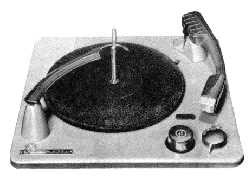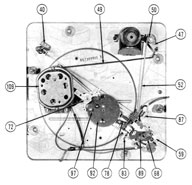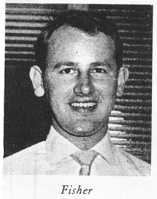|
FOR COLLECTORS, ENTHUSIASTS, AND FRIENDS OF V-M CORPORATION AND ITS PRODUCTS
Vol. 5. No. 2. www.thevoiceofmusic.com April, 2000
Published by Gary Stork four times a year (January, April, July, and October).
FROM THE EDITOR ....
I have to thank my good friend Michael Tokarski for putting together such a fantastic website. Have you seen it? Not on the internet yet? GO OUT and buy a computer (or web TV which is very simple) and check it out! The address is www.thevoiceofmusic.com and it is brought to you by V-M Audio Enthusiasts. You will be greeted by the masthead at the top of this newsletter, accompanied by a beautiful light green background with the classic V-M logos ("wallpaper" in computer speak). You will also hear vintage 1957 audio - "the choice for music is the Voice of Music®"! The purpose of the website is of course, to continue and extend the mission of this Newsletter and V-M Audio Enthusiasts - namely, to foster interest in collecting and restoring V-M products, and to preserve the memory of V-M Corporation's role in audio history. The website will be home to all future issues of this Newsletter.
Here’s an update on phonograph idler wheels. V-M Audio Enthusiasts at present has all wheels in stock. Most are NOS (New Old Stock), but the popular 22915/35429/45000 (Walsco 1496-05) single step idlers and the 7435/9092/19388/24700 (Walsco 1499-09, 1453) double step idlers are available as rebuilt wheels with a new rubber driving surface. This is a labor intensive process, and why we must charge $19.50 each. Furthermore, each wheel will only be shipped after receiving payment and your old wheel. This policy is absolutely necessary to keep a supply of hubs for rebuilding. We get a break in price for sending in these hubs in quantities, and pass the savings on to you. Contact V-M Audio Enthusiasts at the Newsletter return address or email me to order a wheel and obtain final price with shipping and sales tax (MI only).
Interview with Mercer Fisher
One hot August evening last year, I came home from work to discover a nice letter and a few V-M collectible documents courtesy of Mercer Fisher! He and his wife had recently had dinner with Vic and Tenney Miller, and learned of our little publication. I finally caught up with him this winter, and what follows are the results of our amiable chat:
V-MCV: Your first job at V-M was working for Jim Reeves (V-MCV Newsletter April 1999)?
Mr. Fisher: Yes, I hired in as a stock chaser in September, 1948. I had attended Northrop School of Aeronautics on the GI Bill, but after I graduated, there were no jobs in the aircraft industry. My brother-in-law Dick Grose, Consumer Products Sales Manager at V-M, said "Why don’t you come back here and get a job at V-M. This company is really taking off."
V-MCV: You obviously didn’t chase stock for long!
Mr. Fisher: No, I only did that for about six months (Victor Miller comments: When Mercer quit chasing stock, it was not too long until he started chasing June who also worked at V-M and before too long became his wife - and still is.). There was a fellow in engineering named Bob Williams. He mentioned that they needed people on the drafting boards up in engineering. So he introduced me to Doug Smith and Bailey Canfield, and they put me on the drafting board. We were just designing and developing the 900 series changer. That’s the one with the unitized construction, and the works assembly that fits beneath the baseplate. I worked evenings for Floyd Lipscomb to 9 or 10pm at night - some days too, as that was a rush program to get that changer in production.
|

|

|
|
Model 935
|
Model 935 from underneath
|
An interesting story on the 900 series. Roy Parr, head of Industrial Sales, and Norm Vernon were taking prototypes out to show our OEM (original equipment manufacturer) customers. When Roy and Norm went to Zenith to talk to the engineering and purchasing people, they were demonstrating this new changer. The changer wouldn’t center trip and drop the record. So Norm discretely had this thumb underneath to manually trigger the trip mechanism so that it really would cycle. They thought they were getting away with it but when they got all done with the conversation, the buyer said that they might be interested in 10,000 changers if they could also get 10,000 thumbs!
When Roy and Norm got back to the plant, we found out the changer wasn’t working properly because of too much friction. That trip link in the works assembly has to slide. It was originally made of steel and we went to aluminum to lighten the trip link. That worked better but had its problems too in that it would bend easier. It seems we were always looking for ways to reduce trip link friction. When LP records came out, we had to go to lighter needle pressures to avoid damaging the record grooves. Where as before, we were tracking 8-10 grams, after the LP came out we were tracking at 3-4 grams. That meant we had to have even lower friction on that trip link. When stereo LP’s came out we had to lighten needle pressures even further, so we ultimately put a ball bearing on the slide assembly, so the trip link would experience lower rolling friction rather than sliding friction.
There is an interesting story on how we discovered that trip link friction was the problem. There was a fellow in St. Joseph that had a drug store and a camera shop. He was very good with high speed photography. We called him in and he took movies of the cycling operation with a high speed camera. When we played it back in slow motion, we could see what the problem was - the trip link was moving in jerky starts rather than in a nice smooth progression.
V-MCV: That’s a good piece of engineering detective work! Sometimes, the Research and Development group got pretty far afield from record players and tape recorders, didn’t they?
Mr. Fisher: Yes. One funny story is from the 1950’s when color TV was being developed. RCA at the time was working on a three color disk that would mechanically spin in front of the picture tube. That meant the set had to be about twice as wide as a B&W set. So Don Morrison and some of the R&D engineers got the idea to make the color disk more like a drum, that would spin around the unit. The only problem was to keep in sync with the picture, they had to crank up the speed to the point where it blew up on them! Parts were flying all over the laboratory, so they had to give up on that one. CBS was pursuing an electronic solution with the 3 color guns that we have today.
|

|
The photo at left was taken from the June, 1955 “Needle-talk” - the official magazine of the men and women of V-M Corporation. Here is an excerpt of text that accompanies the photo:
On May 2 MERC FISHER was transferred from Sales Coordinator to Export Supervisor. He is responsible for the distribution of jobber models to our various export distributors throughout the world. He also co-ordinates product changes and shipment of parts and assemblies to V-M licensed manufacturers in Mexico, Brazil and Canada. He has been at V-M for five and on-half years.
Merc was born and reared in St. Joseph and attended Michigan College of Mining and Technology and the Northrup Aeronautical
|
V-MCV: In my previous discussions with Victor Miller, he mentions your accomplishments in International Sales.
Mr. Fisher: When the Korean War broke out, I got a letter from Boeing offering me a job in their plant in Washington. Ken Bishop the General Sales Manager heard about it and made me an offer that kept me at V-M. I worked for Ken for a couple of years as Sales Coordinator - which involves communicating between the customer and our engineering people on such things as specifications, color, and cartridges for the record changers. When Ken left in the mid-50s’ to become president of Bell Sound, his responsibilites were broken up such that Roy Parr became OEM Sales Manager, I took over International Sales, and we hired Bud Cain to head up Consumer Products.
We had a license agreement with a German firm called Telefunken, to produce the V-M changer for the German Market under their own label. We also had a manufacturing agreement with a firm in Mexico who tooled some items and imported others. We also had a licensing agreement with ITT for Chile and Argentina. Then we also sold record changers in kit form, requiring only the assembly labor that we would have done on our final assembly line. These were sold in bulk pack, painted baseplates, record platters with the mats already glued on, built up works assemblies, etc. We sold those all through Central America. The reason for selling them as kits was that we could get a reduction in duty rate if the imported product required local labor.
V-MCV: So you ended up your career as Director of Engineering?
Mr. Fisher: I kind of eased into that in 1974 or 1975. I began to help Vic keep tabs on everything that was going on in Engineering, mostly contract work for others in the later days, when our business had deteriorated to the point that we didn’t have enough V-M design work to support the engineering staff. Let me give you one example of contract work from 1976, for RCA in Indianapolis. They were developing the video disc player at the time. A couple of V-M engineers have patents on a device to stabilize the turntable speed, which was so vital to the performance of that player. In fact the fundamental idea behind the stabilizer was later used by RCA to come up with a design to stabilize satellites in orbit. The lead design engineer on this project at V-M was Bob Hammond. We did some metal stampings and plastic parts in our model shop, and built the case by hand for a prototype of the table model.
Getting paid for that contract work was a bit of a challenge. RCA’s engineering organization had their own purchasing group. They were sending us purchase orders for the work we were doing. Problem was that the central buyer still had to approve the invoices for us to get paid, and his nose was out of joint because we were getting purchase orders directly instead of the usual practice of being sent out for quote. So I had to go down and sit with him to straighten matters out and then walk over to Accounts Payable to get a check cut. I hopped back in my car and went to a phone where I called Vic and said that he could send the checks out to pay our suppliers because I had enough money to deposit the next day to cover them! The kicker is that shortly afterwards, that RCA central buyer went to Zenith as their record changer buyer, and we had to work with him there!
Vic had his hands full keeping the operation above water. I hired a man from Electro-Voice, Don Krajecki to head up International Sales. That freed me up and Vic put me in charge of Engineering. In 1976, we made TV games by the thousands for Factory Direct Marketing in Livonia, Michigan. Black and white - you could play Hockey or Ping Pong. I remember Vic would make a fast run in his car if necessary for parts needed to sustain production six days a week. After the bankruptcy, Vic called me back, and we started up the changer line to convert parts into finished products. Our customers had to pay in advance, as we couldn’t use creditors money. We did that in 1977 and 1978, along with making some A/V phonographs for Nationwide Electronics in Canada.
One of the companies that V-M did contract work for was "Tapecon" of Rochester, New York. After V-M’s assets were finally liquidated in 1979, "Tapecon" formed "Voxcom" and built a manufacturing plant in Georgia to produce the product developed at V-M. Mercer Fisher was hired as General Manager of that plant. In 1987, Mr. Fisher bought "Voxcom" and ran it until retiring in 1997.
The purpose of the V-M Collector's Voice Newsletter is to foster interest in collecting and restoring V-M products, and to preserve the memory of V-M Corporation's role in audio history. The Newsletter is available free at www.thevoiceofmusic.com. Paper copies will be sent out to as many people as is economically possible by Gary Stork at the return address. A $2.00 donation would be helpful. Inquiries can also be made regarding back issue availability. Written material from subscribers is actively solicited and greatly appreciated! All material is verified with the originator before published. Mistakes do happen from time to time, and will be corrected in a subsequent issue.
|

![]()


